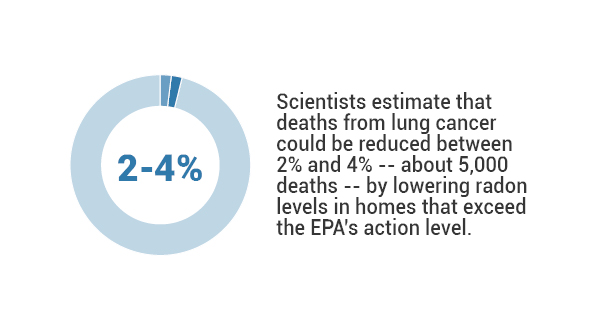We exist in the presence of innumerable unseen dangers. As if there weren’t enough visible dangers for us to avoid on a daily basis, we have to defend ourselves against the unseen. Some of these are residents in our own homes, but so many of us remain blissfully unaware.
The most common invisible residential danger we hear about is carbon monoxide. The invisible, odorless substance that can fatally poison people gets an understandable amount of attention. What we don’t hear much about is a similarly toxic substance that infiltrates our homes: radon.
Scientists estimate that deaths from lung cancer could be reduced between 2% and 4% — about 5,000 deaths — by lowering radon levels in homes that exceed the EPA’s action level. Lung cancer rings all sorts of warning bells. Because many aren’t sure about what radon is, let alone action levels concerning the substance, we’ve put together some frequently asked questions about radon that you should know the answers to.
What is radon?
Radon is a naturally occurring gas that’s slightly denser than the air we breathe. In short, it’s a radioactive, carcinogenic gas that you can’t see, smell, or taste. It comes from the soil and radon testing commonly finds that it’s the lowest levels of a home that are affected by it. The closest liveable level to underlying soil is usually where the bulk of radon will be detected and where it steals into your home.
Should I worry about radon?
Exposure to any radioactive, cancer-causing substance is cause for concern. Radon in your home carries the potential to cause extensive health problems all the up to fatal lung cancer. In fact, radon is the second leading cause of lung cancer in the United States next to smoking. The only way to know if radon is present in your home is residential radon testing services.
What do my radon test results mean?
Nationally, the air we breathe outdoors carries a radon level of 0.4 pCi/L. This naturally occurring outdoor level of radon has been established as the national standard at which indoor radon levels shouldn’t exceed (the EPA’s action level). If your home tests at or above this level of radon, it’s highly recommended that you pursue some manner of radon abatement as soon as possible.
Exposure to radon doesn’t manifest itself in health issues overnight, the process is slow and acts over time. This is why, as soon as you’re looking into a home or haven’t tested your own, you should check on radon levels. Either you’ll find peace of mind or you’ll be thankful that radon testing uncovered something dangerous to be remedied much sooner rather than later.


Recent Comments